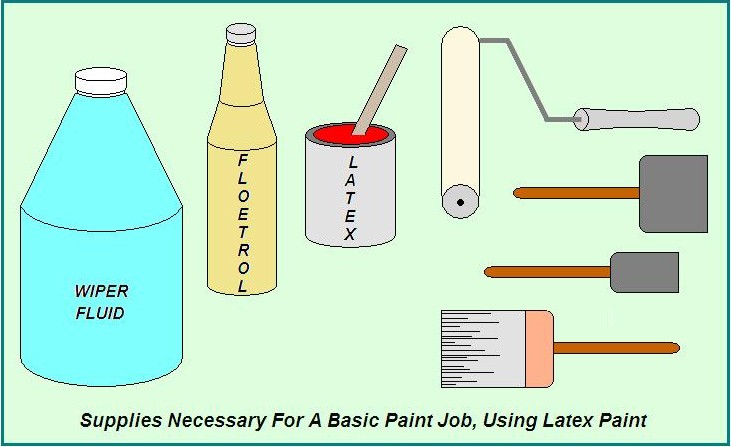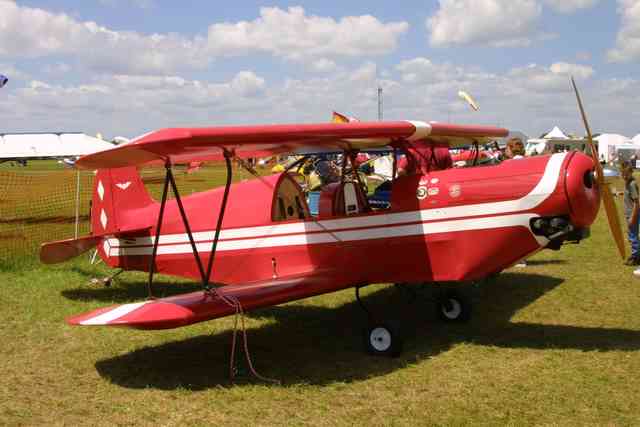HOUSE PAINT ON MY AIRPLANE?
|
|
By: Charles Threewit
Published: July, 2002 Custom Planes Magazineģ
Todayís modern latex paints are miracles of chemistry.
Someone queried the members of the EAA on their web site about using
latex paint on aircraft, and the responses were interesting. |
|
|
Some people had used it. One gentleman said he was 72
years old and had been in aviation for 55 years. He thought these
facts gave the knowledge to predict dire results from its use.
His attitude, and that of the other nay Sayers, reminds me of when the
Wright brothersí father, a few days before their historic escapade at
Kill Devil Hills, emphatically said to the press that ďIf God had
wanted men to fly, heíd have given them feathers!Ē Or itís similar to
the sagacity of the long-departed IBM CEO, who said, in the late 1970s
that ďAs near as I can calculate, there will be a worldwide market for
a total of about five home computers.Ē
Actually, the following are several good reasons to give serious
consideration to the use of latex paint on fabric-covered aircraft:
*A low cost of about $20 a gallon, compared to several hundred dollars
per gallon for more exotic paints
*Ease of application and total lack of toxicity
*Its tenacious hold on fabric fibers
*Its flexibility
*Its resistance to UV damage
*An infinite variety of colors
*The dealerís ability of computer-match paint samples
Years ago, model aircraft builders who had an aversion to the cost of
automotive-type paints discovered the usefulness of latex paint on
aircraft. And, in many cases, they didnít have the equipment or the
knowledge for proper application of these exotic materials. In
addition, automotive paints require expensive breathing apparatuses;
in curing they give off cyanide and theyíre extremely unfriendly to
the environment. Many award-winning giant-scale model aircraft are
finished with latex paint today, and there are several web sites
devoted to the subject.
Note: To be called ďgiant-scale,Ē a model has to be at least ľ scale
or have a wingspan of al least 80 inches for a single wing or 6o
inches for a biplane.
One excellent article on painting and detailing giant-scale models can
be found at http://www.modelairplanenews.com/how_to/latex.asp. The
author, a nationally known, award-winning modeler, has used latex to
finish his planes since 1983. He had been using expensive epoxy paint,
but he couldnít match the colors on a plane he had repaired after a
crash. He went to the local Benjamin Moore dealer for help and learned
they could match the colors exactly-for about 1/8 the costĖby using a
computerized spectrometer. After refinishing the model with Benjamin
Moore latex applied over conventional automotive primer, he was
surprised to discover that the newly repaired plane was now 4.5 pounds
lighter than the original had been-even with all the extra material
used for the repairs.
Itís interesting that the SR-71 Blackbirds on display at the Blackbird
Airpark in Palmdale, California, were painted with black latex to
protect them from the vicious UV content of the high-desert sun.
During flight, the planeís skin temperature approached 575 degrees F,
so latex obviously wouldnít be suitable for flight. But, it works
great to protect the grounded birds from the ravages of the desert
sun. |
|
 |
The
picture (above) shows all the equipment required for a basic paint job
using latex paint. In the center is the paint; I used a can of bright
red I had sitting on my shelf. To the right of the paint are a foam
roller, a couple of foam brushes and a good-quality bristle brush. To
the left of the paint is a product called Floetol. It lowers the
viscosity and surface tension of the paint and helps it to spread more
easily, making for thinner coats and easier application.
The jug on the far left contains windshield-washer solvent. Itís an
excellent thinner for latex paint, although the paint folks wonít
recommend it (they recommend no thinning or thinning with water only).
Latex paint contains ammonia and so does windshield-washer solvent.
The solvent also contains small quantities of detergent, which also
contributes to ease of spreading. Small brush marks left in the paint
quickly even out while the paint is still wet and small marks continue
to disappear over the next several days. And cleanup is with water, as
long as the paint is still damp. Like any other paint, it resists
solvents after it dries. After all, thatís what itís for, isnít it? By
the way, latex is impervious to gasoline after it sets.
Latex is also easy to spray, although most folks recommend brushing on
the first coat to control the application of the paint to the raw
covering material, which should be cleaned with MEK to remove any
grease, oil or residue from adhesives. Care must be taken in this
step; obviously, because MEK is the solvent used in the adhesives, and
we certainly donít want to loosen the covering after itís applied and
stretched.
Just as in the application of sealers and primers, care must be taken
not to apply such a heavy layer of paint that puddles begin to form on
the backside of the cloth. Thatís the reason for the recommendation to
brush the first coat, which allows much better control for those of us
who arenít expert spray painters.
Latex doesnít form a chemical bond with the fibers of the covering,
but it forms a tenacious mechanical bond as it wraps around them.
Succeeding coats then form an excellent bond to the preceding coats,
especially if the last coat has been scuff-sanded. Note that latex
paint doesnít like being wet-sanded. Even when itís well cured if itís
kept wet for any length of time, itíll begin to roll up under the
sandpaper. When it must be feathered it must be done with care,
patience and practice.
When spraying my models, I use either an automotive-type touch-up
spray gun or an airbrush. Iíve used my quart-size gun to spray my
house with latex, and it works just as well with latex as the others.
I have a 2-hp compressor I use with the larger guns, and Iíve always
used my small diaphragm-type compressor with the airbrush, although
thereís no reason not to use the larger compressor with it. Itís
essential that the compressor is equipped with water and oil trap, any
minute quantity of oil in the paint will cause it to fisheye. This
will necessitate removing the paint. Fortunately, any goofs we make
can be immediately corrected while the paint is still wet. Just use a
wet rag to wipe it off.
Roy Vaillancourtís Web site has an excellent discussion about the way
he prepares his paint for spraying. He also writes about the
application of the paint. For him, itís usually on fiber glassed and
primed surfaces, but the principle is the same. Start with a very
light coat, and after drying; add two more coats, with the second
being allowed to dry before adding the third. Because the solvent in
latex is water, the paint dries rapidly, depending on the temperature
and humidity. Vaillancourt uses a heat gun to dry the paint on his
models.
One of the neat things about latex paint is its opacity. The old rule
about never putting light colors on top of dark doesnít apply with
latex. Although itís still a good idea to use dark over light, it
isnít a necessity with latex. One manufacturer advertised that its
paint contains 48% solids, by weight, far higher than anything else
Iíve seen, other than polyurethane, perhaps. This certainly accounts
for the high opacity of the paint. |
|
Some
folks who use latex on full-scale planes use a base coat of black
paint for ultraviolet protection. However, if the bare fabric is going
to be visible in the finished plane, the black color isnít too
desirable. An interesting Web site (http://www.larryvile.com/dcd/tandem/latex1.htm)
describes the painting of a Ragwing Ultra-Piet (a ĺ-scale Pietenpol
Aircamper).
The author didnít use an undercoat of black on his Ragwing
because he didnít want the black to show in the cockpit. Also, he says
he was concerned about the weight-saving possibilities. He said, ďIf I
was still flying the airplane in 10 years, it would probably be ready
for new fabric anyway, I figured, UV degradation or no.Ē
Then he describes how he devised what he calls ďan accelerated aging
test, something much harsher than it would see on a hangared
airplane.Ē He prepared a sample of fabric, stretched on a wood frame,
and applied single coats of red and white latex to various parts of
it. Then he placed the sample outside, learning against the south wall
of his shop. He left it there for the next 6-1/2 years. Believe me the
south wall, in Lawrence, Kansas, does get a lot of sunshine!
He tested the sample periodically for deterioration of the fabric, and
only at the end of the 61/2 years was he able to detect any UV
deterioration. He makes no claim for the scientific accuracy of his
field test, but he says it satisfied him to know that his plane could
be safely flown without a black base coat. More than one coat of paint
would greatly increase the opacity of the paint and serve even further
to prevent UV damage.
Thereís some humor included in the description of the test. One of the
lower corners of the test sample, painted white, is severely
discolored. Aha! Have we finally found a weakness in latex paint? Does
it turn yellow when exposed to sunlight? Not necessarily. The author
said the yellowing is the effect of canine urine on latex paint!
Hopefully, that wonít be a problem for paint used on airplanes.
Regarding flexibility, the Web site said the author has taken a
painted piece of fabric, wadded it up tightly in his hand, rolled it
about and opened it back up with no cracking or other damage to the
paint. I visited our local paint store and was shown some test samples
that showed the same result. One was a strip of painted plastic that
had been bent doubles, and then a larger weight was applied to fix the
crease. This didnít damage the paint. This flexibility makes the paint
suitable for use on unsupported fabric surfaces that will be subjected
to flexure during normal flight service.
Latex manufacturers all recommend their paint for use on metals and
fiberglass that have been prepared by scuff sanding or the use of
etching solutions and then carefully cleaned. The EAA site has a query
from an aircraft owner seeking information abut how to get latex off
an aluminum-skinned plane. If latex has a fault, itís that itís
impervious to most, if not all, of the normally used paint solvents.
There are solvents available that will remove it, however. Check with
any well-stocked paint store with knowledgeable salespeople.
Most of the large paint stores now have computerized spectrometers
they can use to match any paint sample. The sample is placed in the
spectrometerís viewing window, the computer takes a few minutes to
analyze the color components of the sample and then it prints out a
formula for mixing the paint. Lighting and eyeballs are removed from
the equation. The color chips, that are available at most stores, show
the complete spectrum form which colors can be chosen, and the
computer can match anything in between the chips. This is particularly
useful when trying to repaint repaired surfaces after the surrounding
paint has been weathered enough to begin fading. The computer sees the
sample, as it is, not what it used to be. The formula it gives matches
what it looked at. There may be a difference in the gloss of the
weathered paint and the new paint, but that can usually be taken care
of with a good wax job.
It seems that homebuilders are really missing something if we donít at
least look at the possibilities for using latex paint on our projects,
the nay Sayers not with standing. Where would we be if the Wright boys
had listened to their nay saying father without at least testing their
ideas?
The above courtesy of
http://www.lightminiatureaircraft.com/generic31.html
|
|
|

RagWing bi plane painted with house paint. |
|
|
|
1 2
3 4
5 6
7 8
9 10
11
12 13
14 15
16 17
18
19
20 21
22
23 24
25 26
27 28
29
30
31
32 Index for this section. |
|


